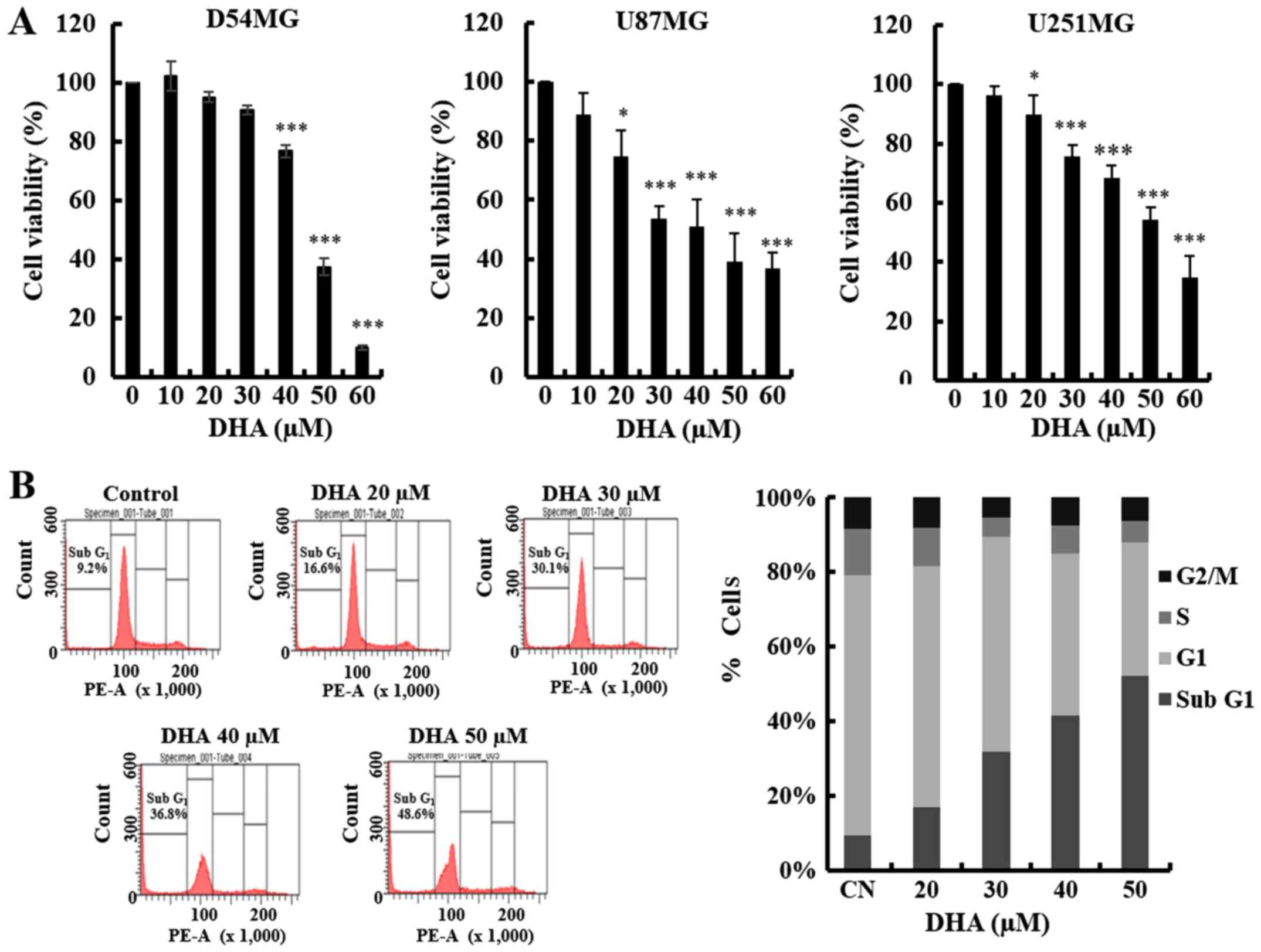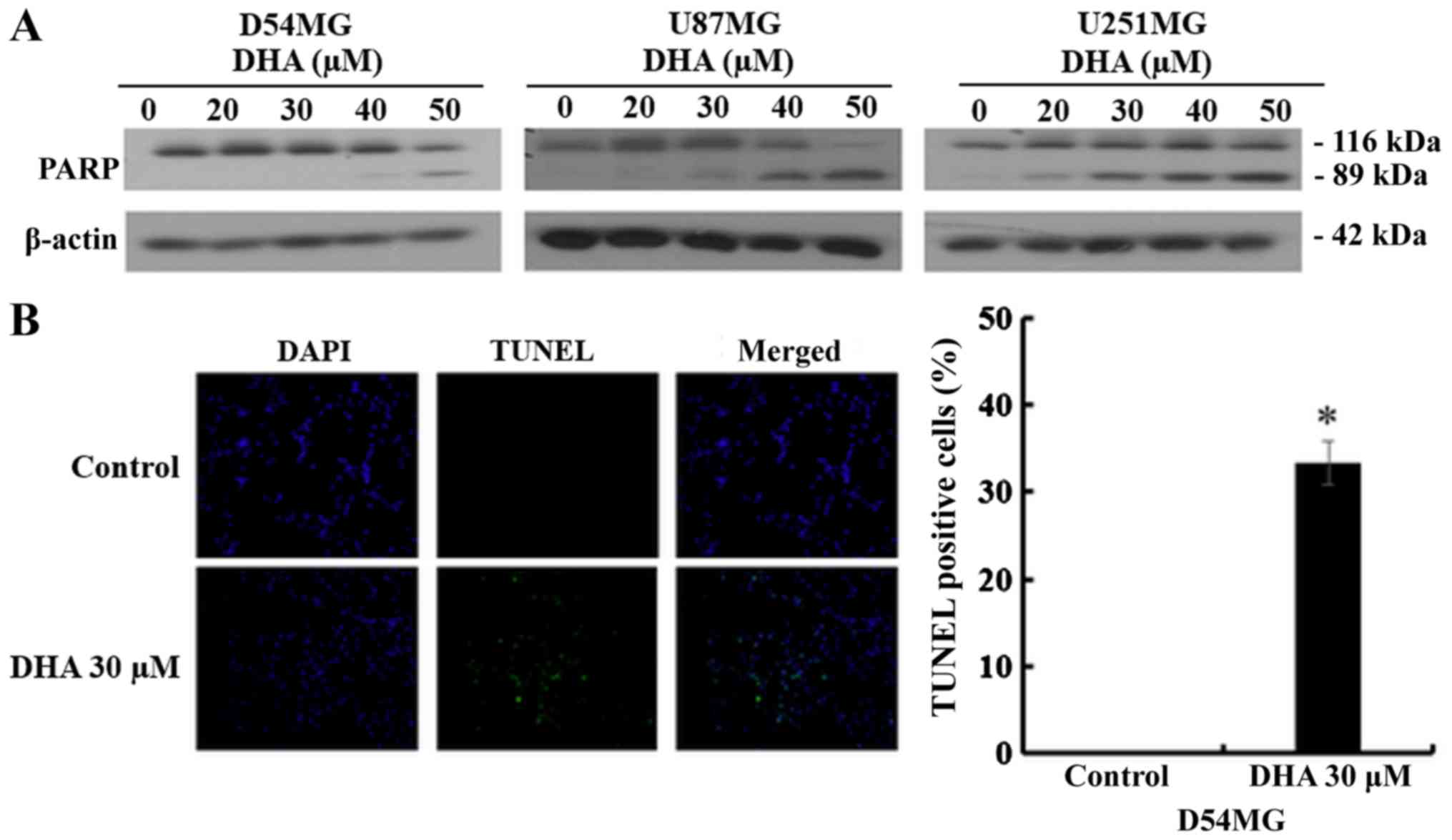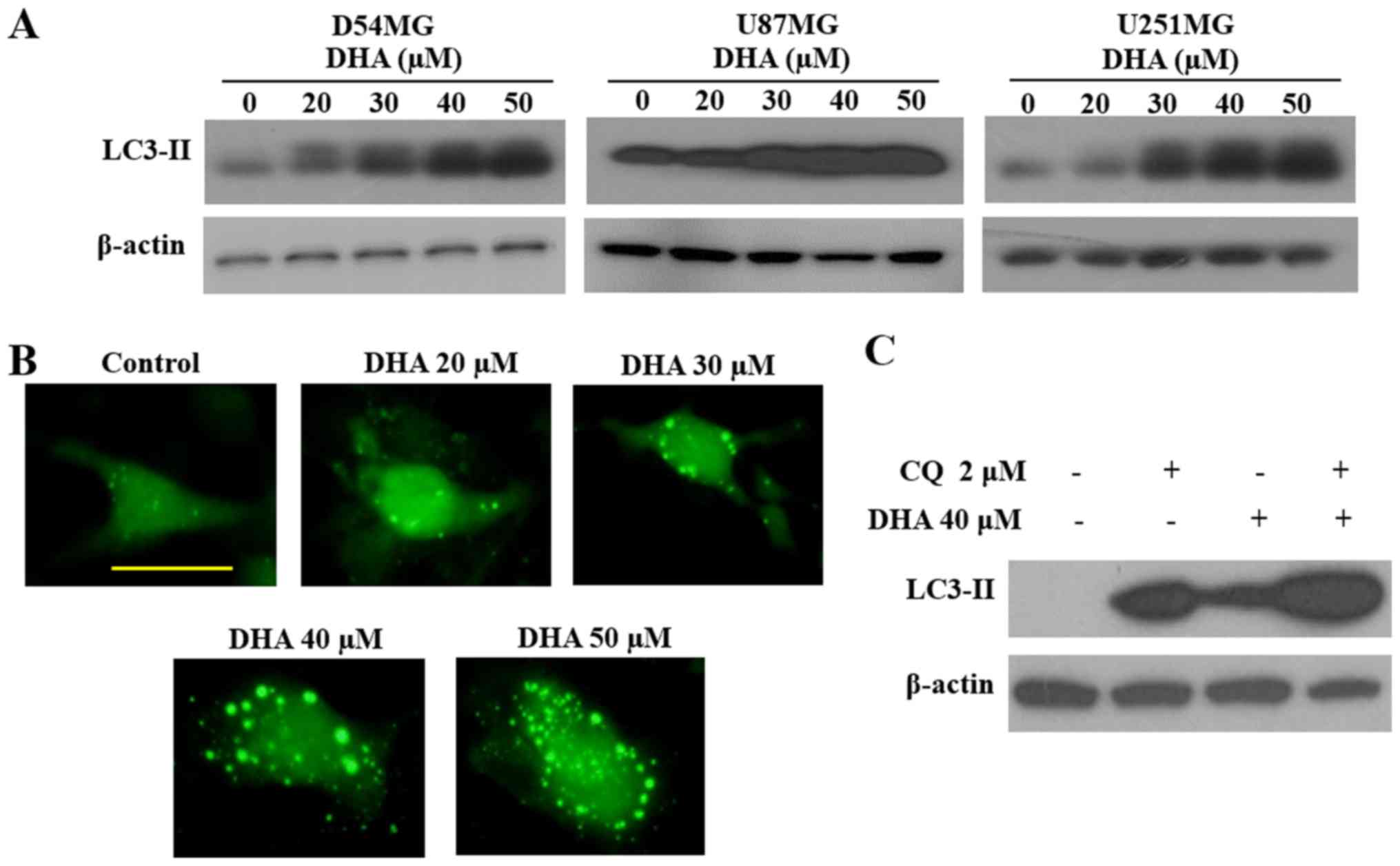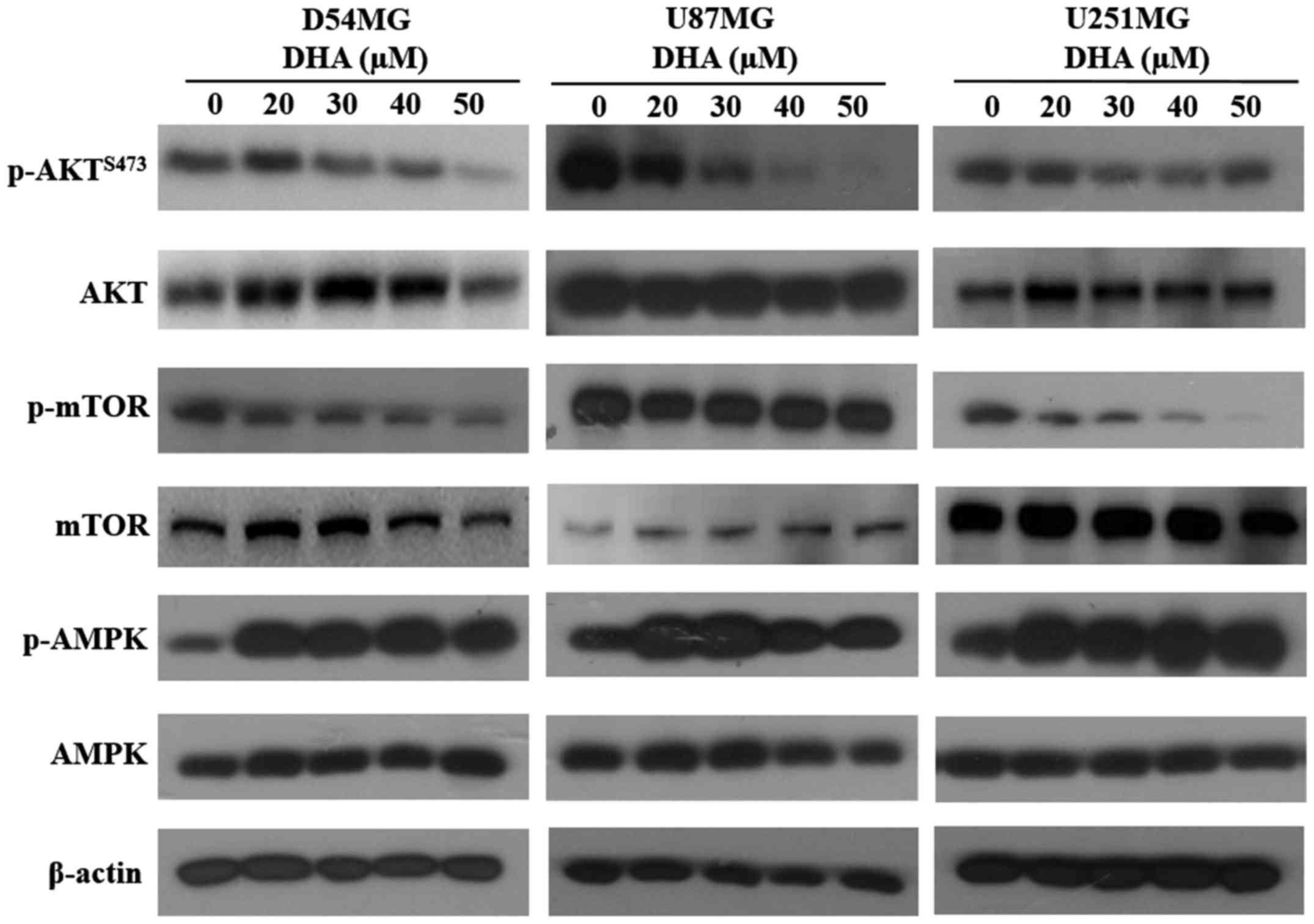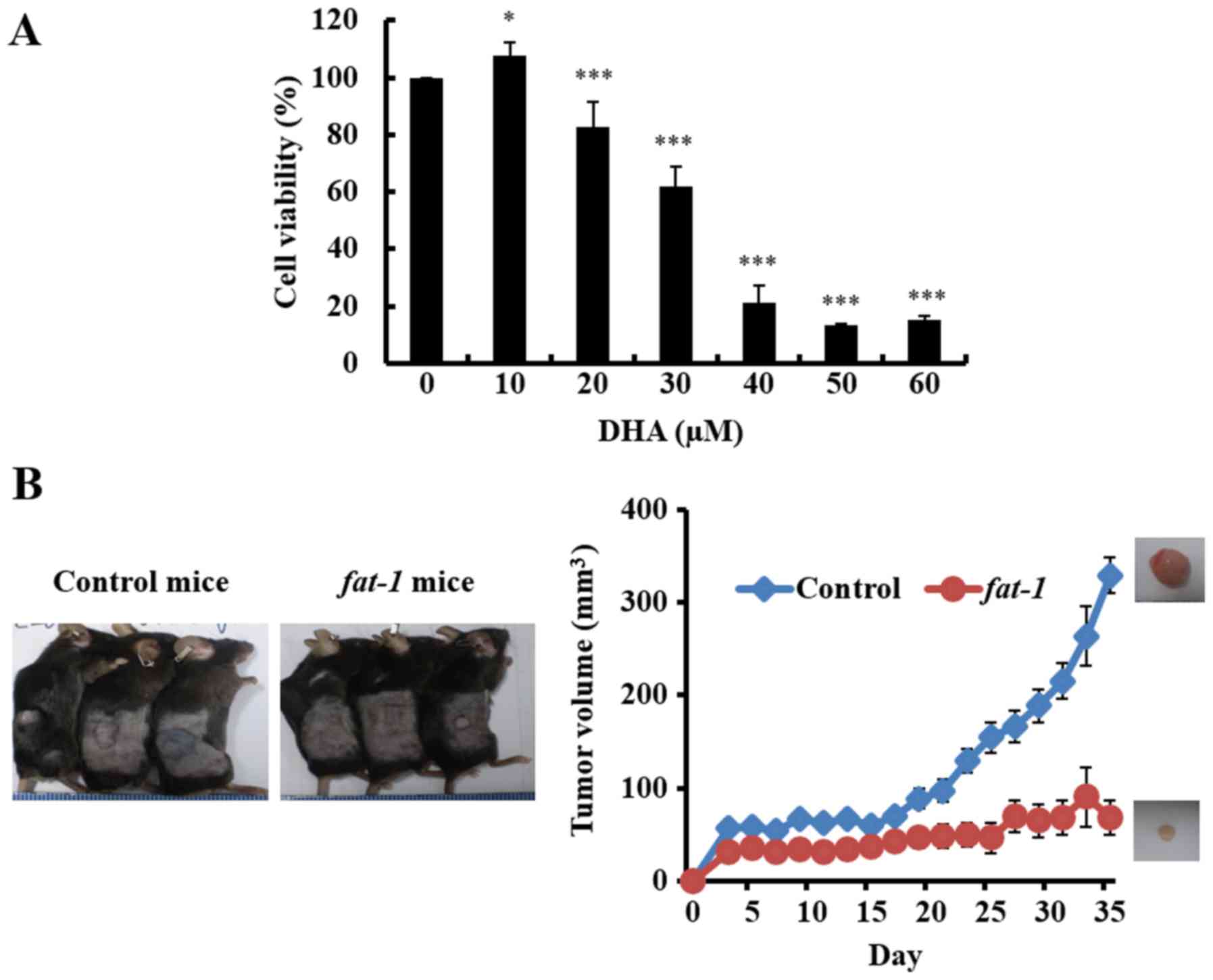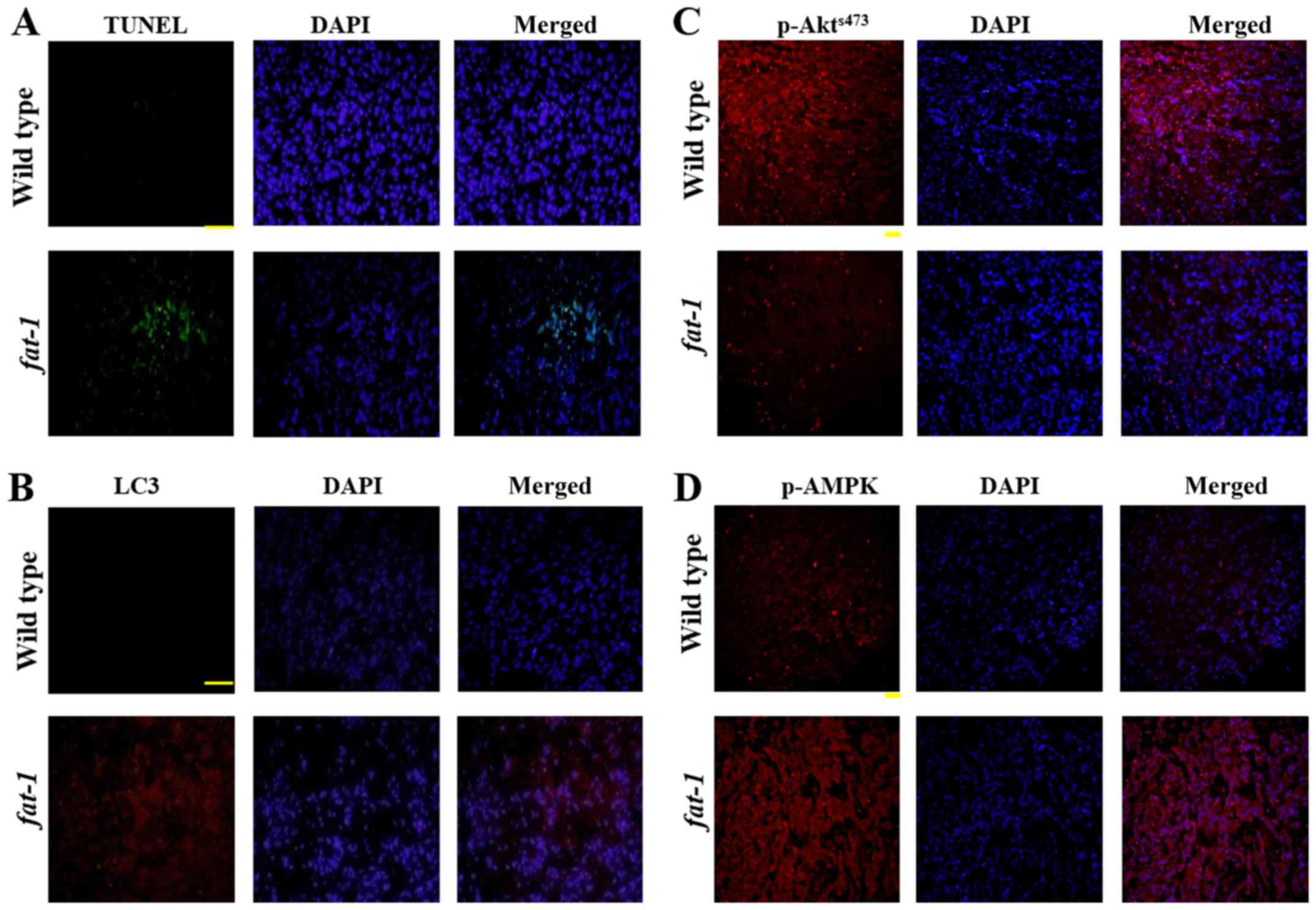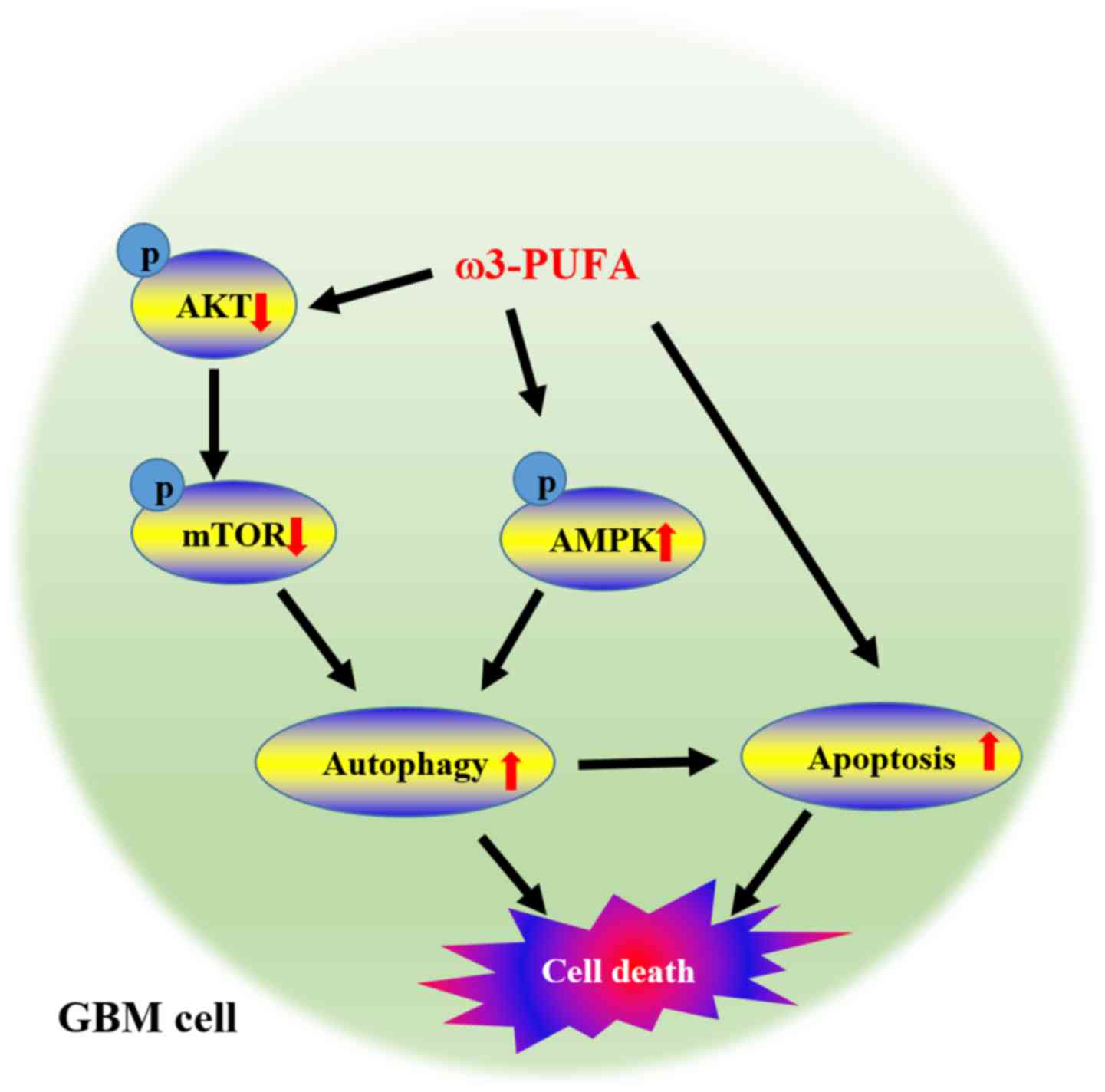ω3-polyunsaturated fatty acids induce cell death through apoptosis and autophagy in glioblastoma cells: In vitro and in vivo
- Authors:
- Published online on: November 16, 2017 https://doi.org/10.3892/or.2017.6101
- Pages: 239-246
Abstract
Introduction
Glioblastoma (GBM) is the most aggressive and deadliest brain malignancy in adults. According to the latest statistics from the United States National Cancer Institute, it is estimated that 23,000 Americans will be diagnosed with brain and other nervous system cancers in 2017 and 16,700 will die from these cancers (1). Gliomas are divided into four grades, of which grade four or GBM is the most aggressive and has the highest incidence (2). GBM progression cannot be controlled by surgical resection, radiotherapy, or chemotherapy, which results in a median survival time of less than 15 months (3). Thus, new therapeutic approaches are needed.
Omega3-polyunsaturated fatty acids (ω3-PUFAs) and ω6-polyunsaturated fatty acids (ω6-PUFAs) are essential nutrients for good health. ω3-PUFAs are long-chain fatty acids that have a double bond between the third and fourth carbon atoms from the methyl end of the carbon chain. The Western diet contains a high amount of ω6-PUFAs, with an ω6-PUFA to ω3-PUFA ratio of approximately 50:1 (4). A high ω6-PUFA to ω3-PUFAs ratio contributes to the pathogenesis of many diseases, including cancer and inflammatory diseases, whereas increased levels of ω3-PUFAs (a low ω6-PUFA to ω3-PUFA ratio) have suppressive effects on these diseases (5). For this reason, nutritionists recommend a diet with an optimal ω6-PUFA to ω3-PUFA ratio of 1:1 (6). We previously demonstrated in numerous studies that ω3-PUFAs, docosahexaenoic acid (DHA) in particular, induce cell death in cancer cells through several mechanisms, including inhibition of Wnt/β-catenin signaling (7–9), activation of mitogen-activated protein kinases (10), inhibition of Cox-2/PGE2 signaling (7,8,11) and inhibition of NF-κB signaling (11). Recently, we reported that DHA induces autophagy through p53/AMPK/mTOR signaling (12) and that autophagy induction enhances apoptosis in human cancer cells (12–14). More recently, DHA was found to induce degradation of HPV E6/E7 oncoproteins by activating the ubiquitin-proteasome system (15). However, the anticancer activity of DHA in GBM cells has not been studied intensively. In addition, the molecular mechanisms of the anticancer activity of DHA are not fully understood. Therefore, in the present study, we investigated the mechanisms underlying the anticancer activity of DHA on GBM in vitro and in vivo.
Materials and methods
Glioma cell lines and reagent treatment
Three human (D54MG, U87MG and U251MG) and mouse (GL261) glioma cell lines were used in the present study. D54MG and GL261 cell lines were obtained from Dr Yancie Gillespie (University of Alabama-Birmingham, Birmingham, AL). To note, the D54MG cell line is misidentified according to the following database: http://iclac.org/wp-content/uploads/Cross-Contaminations-v8_0.pdf. This cell line is contaminated with another human glioblastoma cell line (A-172). U87MG, U251MG and GL261 cells were maintained in Dulbecco's modified Eagles medium (DMEM; Gibco, Grand Island, NY, USA), and D54MG was grown in RPMI-1640 medium (Gibco) supplemented with 10% fetal bovine serum (FBS; Gibco) and antibiotics (penicillin 10,000 U/ml and streptomycin 10,000 µg/ml; Gibco) in 5% CO2 at 37°C. Absolute ethanol was used to dissolve DHA (Cayman Chemical, Ann Arbor, MI, USA). The following antibodies were used in the present study: poly(ADP-ribose) polymerase (PARP) (#9542, Rabbit, Polyclonal, 1:2,000), LC3B (#3868, Rabbit IgG, Monoclonal, 1:5,000), Akt (#9272, Rabbit, Polyclonal, 1:2,000), p-Akt(Ser473) (#4060, Rabbit IgG, Monoclonal, 1:2,000), mTOR (#2972, Rabbit, Polyclonal, 1:1,000), p-mTOR(Ser2448) (#2971, Rabbit, Polyclonal, 1:1,000), AMPK (#2532, Rabbit, Polyclonal, 1:2,000) and p-AMPK(Thr172) (#2535, Rabbit IgG, Monoclonal, 1:2,000). All antibodies were purchased from Cell Signaling Technology (Beverly, MA, USA). Goat anti-rabbit and goat anti-mouse secondary antibodies were purchased from Calbiochem (Billerica, MA, USA).
MTT assay
Cell viability was determined using thiazolyl blue tetrazolium bromide (MTT; Sigma-Aldrich, St. Louis, MO, USA). D54MG, U87MG, U251MG and GL261 cells were seeded onto 96-well tissue culture plates and incubated at 37°C for 18 h. The cells were incubated with serum-free media for 24 h at 37°C, after which the cells were treated with the indicated concentrations of DHA for another 24 h whereas the D54MG cells were incubated for 6 h. The cells were then incubated with 0.005 mg/ml of MTT dissolved in serum-free medium for 1 h at 37°C. After a 1-h incubation, the formazan product, which is indicated by dark blue water-insoluble crystals, was formed in the event the cells were alive. These crystals were dissolved in 100 µl dimethyl sulfoxide (DMSO), the absorbance was then measured at 570 nm, and cell viability was expressed as a ratio vs. the untreated control cells. Each experiment was performed in triplicate.
Western blot analysis
Cells extracts were prepared from 100-mm tissue culture plates. Cell pellets were lysed in cell lysis buffer and then sonicated for 20 sec. The supernatants were prepared by centrifugation at 17,000 rpm at 4°C for 20 min. Cell lysates (30 µg) were separated using 6–15% sodium dodecyl sulfate-polyacrylamide gel electrophoresis (SDS-PAGE). The separated proteins were then transferred to a PVDF membrane (Millipore, Billerica, MA, USA), and the membranes were blocked with 5% skim milk in TBS/T for 1 h at room temperature. The blots were incubated with the diluted primary antibodies overnight at 4°C, followed by incubation with goat anti-rabbit peroxidase-conjugated secondary antibody. The bands were then visualized with the ECL western blotting detection system (WBKLS0500, Millipore) according to the manufacturers instructions.
Flow cytometry assay
For the flow cytometry cell sorting (FACS) assay, both floating and attached cells were collected after the drug treatment, washed in phosphate-buffered saline (PBS), fixed with 70% ethanol for 24 h, treated with 500 µg/ml of RNase A (Sigma-Aldrich), and then stained with 50 µg/ml propidium iodide (PI; Sigma-Aldrich) for 10 min at 37°C. DNA staining with PI was analyzed with a FACSCalibur flow cytometer (BD Biosciences, San Diego, CA, USA).
TUNEL assay
For the TUNEL assay in vitro, D54MG cells were seeded onto glass coverslips in 24-well plates and then grown for 24 h. The cells were then incubated with serum-free media for 24 h at 37°C, and then the cells were treated with 30 µM DHA for another 2 h. Cells were washed with 1X PBS and processed with TUNEL using the DeadEnd Fluorometric TUNEL system (Promega, Fitchburg, WI, USA). Cells were mounted with mounting solution (Dako A/S, Copenhagen, Denmark) with DAPI. The number of TUNEL-positive (green) and DAPI-positive cells (blue nuclear stain) was visually counted. All samples were analyzed with at least two biological replicates, and three images from each replicate were captured using a 10X objective for counting the TUNEL- and DAPI-positive cells. The percentage of TUNEL-positive cells was calculated as (number of TUNEL-positive cells/total number of cells) × 100.
Transfection
Cells grown to 80% confluency were switched to and incubated with serum-free media for 24 h. Transient transfection was then performed with the GFP-LC3 expression vector (a kind gift from Dr Tamotsu Yoshimori, National Institute of Genetics, Mishima, Japan) as recommended by the vendor. After 24 h of transfection, the cells were exposed to the indicated concentrations of DHA for 1 h. The transfected cells were then observed under a fluorescence microscope, and fluorescence imaging was performed to detect the punctate pattern of GFP-LC3B.
Tumorigenicity experiments
Transgenic (tg) mice were kindly provided by Dr J.X. Kang (Harvard University, Cambridge, MA, USA). Control C57BL/6 mice were purchased from Central Lab Animal Inc., Seoul, Korea. The control and fat-1 tg mice were kept under specific pathogen-free conditions and received care according to the guidelines of the Institutional Animal Care and Use Committee of Chungnam National University which approved the protocol of the animal research. Both control and fat-1 tg mice were 6-week-old male mice. Each mouse was subcutaneously injected with 2×106 cells (mouse glioma GL261 cells) in a total volume of 100 µl. The day of implantation was designated as day 0. The tumor size was measured with a caliper every other day. The tumor size was calculated as length × wide, and the tumor volume was calculated as 0.5 × length × (width)2.
Immunohistochemistry
After deparaffinization and antigen retrieval, the tissues were blocked with Dako Protein Block, stained with TUNEL using the DeadEnd Fluorometric TUNEL System (Promega), LC3B (1:3,000; Cell Signaling, Technology), p-AktS473 (1:50; Cell Signaling, Technology), and p-AMPKT172 (1:100; Cell Signaling, Technology) primary antibodies, visualized using an anti-rabbit IgG conjugated secondary antibody with Texas Red and counterstained with DAPI. These fluorescently stained tissues were observed under a fluorescence microscope as previously described using the DP Controller software (Olympus) for image acquisition. Final images were a non-contrast-adjusted merge of the two channels.
Statistical analysis
Statistical analyses were performed as recommended by independent analysis. These included the unpaired Students t-test. All values are expressed as mean ± SD and statistical significance was indicated by P<0.05 (*P<0.05, **P<0.01 and ***P<0.001, respectively).
Results
DHA induces a cytotoxic effect on GBM cells
To investigate the effects of DHA on the growth of GBM cell lines, D54MG, U87MG, U251MG and GL261, the cells were incubated with various concentrations of DHA for 24 h, or 6 h in the case of D54MG cells. DHA decreased the viability of each GBM cell line in a dose-dependent manner, as determined by the MTT assay (Fig. 1A). A decrease in cell viability was observed at DHA concentrations of 20 µM or greater. These findings support the hypothesis that DHA exerts a significant influence on GBM cell proliferation.
DHA induces apoptosis and autophagy in GBM cells
According to recent reports, DHA induces apoptosis in various types of cancer cells by activating both intrinsic and extrinsic pathways (16,17). To assess whether DHA also induces apoptosis in GBM cells, we first analyzed the sub-G1 population of DHA-treated D54MG cells by flow cytometry. As shown in Fig. 1B, DHA induced an increase in the proportion of cells in the sub-G1 phase. To determine whether the observed reduction in cell viability was caused by apoptosis, we assessed the ability of DHA to induce apoptosis in human GBM cells. DHA led to proteolytic cleavage of poly(ADP-ribose) polymerase (PARP), which is widely used as an apoptosis marker (Fig. 2A). Furthermore, TUNEL assay was performed to detect apoptotic nuclear DNA breaks in D54MG cells; after DHA treatment, the number of TUNEL-positive cells increased significantly compared with the untreated control, in which no apoptotic activity was observed (Fig. 2B). These results demonstrated that DHA induced apoptosis in GBM cells.
To evaluate autophagy as another possible mechanism for induction of GBM cell death by DHA, we next performed autophagic cell death experiments. DHA treatment increased the level of LC3B-II, an autophagy marker, in a dose-dependent manner (Fig. 3A). This observation was confirmed in DHA-treated D54MG cells transfected with GFP-LC3B, which showed a greater number of GFP-LC3B puncta compared with untreated cells (Fig. 3B). Moreover, autophagic flux assays in cells pretreated with chloroquine, an inhibitor of lysosomal acidification, provided further confirmation that DHA treatment increased LC3-II expression (Fig. 3C). Altogether, these observations indicate that DHA induces autophagy in GBM cells.
DHA inhibits mTOR signaling through inhibition of Akt and activation of AMPK in GBM cells
The mTOR pathway is one of the most important pathways that regulate both apoptosis and autophagy. This pathway is also directly linked to the Akt survival pathway, leading us to question whether the simultaneous induction of apoptosis and autophagy by DHA in GBM cells was mediated by this signaling pathway. To test this, we first examined the effect of DHA on Akt expression. Treatment of GBM cells with DHA led to a marked decrease in p-AktSer473 levels and a gradual decrease in p-mTOR levels. We also measured AMPK levels, and observed a significant increase in p-AMPK levels after DHA treatment (Fig. 4). These results indicate that DHA suppresses the mTOR pathway in GBM cells through inhibition of Akt and activation of AMPK.
ω3-PUFAs suppress tumor growth in vivo
To evaluate the relevance of these findings in vivo, we employed fat-1 tg mice as a model of elevated ω3-PUFA concentration in tissue. fat-1 tg mice carry a ω3-desaturase gene from Caenorhabditis elegans that converts ω6-PUFAs to ω3-PUFAs, resulting in a significant increase in the concentration of ω3-PUFA and a decrease in the concentration of ω6-PUFAs throughout the body (18). A mouse model of GBM was created using the mouse glioma cell line GL261, which was chosen because this cell line is derived from a GBM from C57BL/6 mice and forms tumors in these mice.
Before implantation of GL261 cells into mice, the effect of DHA on GL261 cells was confirmed in vitro. Consistent with the results obtained in human GBM cells, DHA significantly decreased the viability of GL261 cells (Fig. 5A).
GL261 cells were implanted into fat-1 tg mice and control mice (C57/BL6 genetic background), and the tumorigenicity of the inoculated cells in these mice was examined. As shown in Fig. 5B, there was a marked difference in tumor volume between fat-1 tg (n=5) and control mice (n=5). After 35 days, the average tumor volume was 75% lower in the fat-1 tg mice than the tumor volume noted in the control mice (Fig. 5C). To determine whether apoptosis and autophagy were also related to the inhibition of tumor growth observed in vivo, we performed TUNEL assays and measured LC3 levels in the tumor tissues. Both the proportion of TUNEL-positive cells and the level of LC3B were higher in the tumor tissue derived from fat-1 tg mice than in tumor tissue derived from wild-type mice (Fig. 6A and B), indicating that both apoptosis and autophagy are involved in the reduction of tumor growth in fat-1 tg mice. Subsequently, to determine whether Akt and AMPK were also related to the increase in apoptosis and autophagy in these mice, the levels of Akt and AMPK in tumor tissue were analyzed by immunohistochemistry. As shown in Fig. 6C and D, the level of p-AktSer473 was reduced and the level of p-AMPK was elevated in tumor tissue derived from fat-1 tg mice, compared with tumor tissue derived from the control mice. These data demonstrate that ω3-PUFAs induce both apoptosis and autophagy in vivo by regulating AMPK and Akt/mTOR signaling (Fig. 7).
Discussion
Compelling evidence from many studies has demonstrated that DHA induces apoptosis and protects against a variety of cancers, including lung cancer, via multiple targets (8,13). Although the anticancer mechanisms of ω3-PUFAs in several cancers have been reported, the relevant mechanisms are still unclear in the case of brain cancer. In the present study, we used in vitro experiments and in vivo mouse models to evaluate the anticancer activity of ω3-PUFAs against GBM. DHA treatment induced dose- and time-dependent growth inhibition in three human GBM cell lines. Of these three cell lines, D54MG cells were selected for further experiments as the viability of D54MG cells was reduced by only ~20% after DHA treatment. The observations that DHA induced an increase in the concentration of cleaved PARP in D54MG cells, with a concomitant increase in the sub-G1 cell population, as demonstrated by cell cycle analysis using flow cytometry, confirmed that DHA induced apoptotic cell death in D54MG cells (Figs. 1 and 2). Additionally, using the TUNEL assay, a common method for detecting DNA fragmentation resulting from apoptotic signaling cascades, the proportion of TUNEL-positive D54MG cells was shown to increase after DHA treatment (Fig. 2B). Gobeil et al (19) reported the possible implication of lysosomal enzymes in the necrotic cleavage of PARP-1. They observed two major PARP-1 fragments (a C-terminal 55 kDa active and a N-terminal 62 kDa inactive fragment) after necrotic inducers like H2O2 in Jurkat T cells. In our data, only an 89-kDa fragment was observed after DHA treatment (Fig. 2A) in the GBM cells. These results strongly indicate that DHA induced apoptotic cell death, not necrotic cell death in the GBM cells.
Autophagy and apoptosis have been shown to be interconnected by crosstalk between several molecular nodes. The functional relationship between apoptosis and autophagy is complex; in some circumstances, autophagy constitutes a stress adaptation to avoid cell death, whereas in other circumstances, it constitutes an alternative cell death pathway. Both autophagy and apoptosis can be triggered by a common upstream signal (20). Jing et al (13) reported that autophagy and apoptosis occur simultaneously and act cooperatively to induce cell death after DHA treatment. To determine whether autophagy is also induced by DHA in GBM cells, we first examined the levels of LC3-II, an autophagy marker. DHA increased the expression levels of LC3-II in three GBM cell lines (Fig. 3A). These results were confirmed conclusively in D54MG cells transfected with GFP-LC3, which showed a higher number of GFP-LC3 puncta after exposure to DHA (Fig. 3B). Moreover, autophagic flux assays in cells pretreated with chloroquine, a lysosomal inhibitor, confirmed that DHA markedly increased LC3-II expression (Fig. 3C). These results clearly demonstrated that DHA induces GBM cell death by both apoptosis and autophagy.
The Akt/mTOR pathway is one of the most frequently dysregulated pathways in several types of cancers. Several selective inhibitors of Akt and mTOR have been investigated, both in preclinical tumor models and in various clinical trials; however, these inhibitors have been found not to improve survival significantly because of feedback activation of the Akt/mTOR pathway (21). Several other studies have shown that DHA inhibits the Akt/mTOR pathway in various cancer cells, including prostate cancer cells (14,22). We therefore assessed whether inhibition of Akt/mTOR signaling is also related to apoptotic and autophagic cell death in GBM by testing the effect of DHA exposure on Akt and mTOR levels in three GBM cell lines. DHA treatment caused a dose-dependent decrease in p-AktSer473 and p-mTOR levels, suggesting that DHA-induced autophagy is related to the inhibition of mTOR through downregulation of p-Akt.
mTOR receives signals from nutrients, growth factors, and many cellular kinases, including AMPK. Phosphorylation of AMPK activates downstream signaling that triggers mTOR inhibition and autophagy (23,24). Jing et al (13) reported that DHA inhibits mTOR through AMPK activation. Our data confirmed that DHA increases the level of p-AMPK and that DHA-induced autophagy is related to inhibition of mTOR through activation of AMPK.
To support these in vitro data, we performed in vivo experiments using fat-1 tg mice, implanting GL261 mouse glioma cells into fat-1 tg mice and wild-type mice. fat-1 tg mice ubiquitously express a C. elegans ω3-desaturase, leading to a significant increase in the ω3-PUFA/ω6-PUFA ratio across all organs and tissues (18). This mouse model was selected as the endogenous source of ω3-PUFAs provides a consistent ω3-PUFA concentration and eliminates potential dietary variations associated with long-term feeding of ω3-PUFAs. A significant reduction in GL261 primary tumor growth was observed in the fat-1 tg mice (Fig. 5B), and tumor tissue derived from fat-1 tg mice exhibited an increase in the proportion of TUNEL-positive cells (Fig. 6A) and LC3-II levels (Fig. 6B) compared with tumor tissue derived from wild-type mice. These findings provide important in vivo evidence for growth retardation of GL261 cells by ω3-PUFAs via induction of apoptosis and autophagy. Moreover, we confirmed that p-Akt levels were reduced (Fig. 6C) and p-AMPK levels were elevated (Fig. 6D) in tumor tissue from fat-1 tg mice, compared with tumor tissue from wild-type mice. Thus, the present study clearly demonstrates that ω3-PUFAs, including DHA, induce GBM cell death through repression of mTOR via Akt inhibition and AMPK activation (Fig. 7). In summary, this study provides important information on the mechanism underlying the antitumorigenic activity of ω3-PUFAs and encouraging preclinical evidence for a possible strategy for the chemoprevention and treatment of GBM. Therefore, it is possible that ω3-PUFAs, being non-toxic, may represent safe chemopreventive and therapeutic agents for GBM patients.
Acknowledgements
This study was supported by the National Research Foundation of Korea (NRF) grant funded by the Korea government (MSIP) (NRF-2015R1D1A1A01056887) and research fund of Chungnam National University (2014). We thank Dr Jing X. Kang at the Harvard Medical School for providing the Fat-1 transgenic mice.
References
|
Siegel RL, Miller KD and Jemal A: Cancer Statistics, 2017. CA Cancer J Clin. 67:7–30. 2017. View Article : Google Scholar : PubMed/NCBI | |
|
Holland EC: Glioblastoma multiforme: The terminator. Proc Natl Acad Sci USA. 97:pp. 6242–6244. 2000; View Article : Google Scholar : PubMed/NCBI | |
|
Preusser M, de Ribaupierre S, Wöhrer A, Erridge SC, Hegi M, Weller M and Stupp R: Current concepts and management of glioblastoma. Ann Neurol. 70:9–21. 2011. View Article : Google Scholar : PubMed/NCBI | |
|
Simopoulos AP: Human requirement for N-3 polyunsaturated fatty acids. Poult Sci. 79:961–970. 2000. View Article : Google Scholar : PubMed/NCBI | |
|
Simopoulos AP: Omega-3 fatty acids in inflammation and autoimmune diseases. J Am Coll Nutr. 21:495–505. 2002. View Article : Google Scholar : PubMed/NCBI | |
|
Simopoulos AP: The importance of the ratio of omega-6/omega-3 essential fatty acids. Biomed Pharmacother. 56:365–379. 2002. View Article : Google Scholar : PubMed/NCBI | |
|
Song KS, Jing K, Kim JS, Yun EJ, Shin S, Seo KS, Park JH, Heo JY, Kang JX, Suh KS, et al: Omega-3-polyunsaturated fatty acids suppress pancreatic cancer cell growth in vitro and in vivo via downregulation of Wnt/Beta-catenin signaling. Pancreatology. 11:574–584. 2011. View Article : Google Scholar : PubMed/NCBI | |
|
Lim K, Han C, Dai Y, Shen M and Wu T: Omega-3 polyunsaturated fatty acids inhibit hepatocellular carcinoma cell growth through blocking beta-catenin and cyclooxygenase-2. Mol Cancer Ther. 8:3046–3055. 2009. View Article : Google Scholar : PubMed/NCBI | |
|
Lim K, Han C, Xu L, Isse K, Demetris AJ and Wu T: Cyclooxygenase-2-derived prostaglandin E2 activates beta-catenin in human cholangiocarcinoma cells: Evidence for inhibition of these signaling pathways by omega 3 polyunsaturated fatty acids. Cancer Res. 68:553–560. 2008. View Article : Google Scholar : PubMed/NCBI | |
|
Jeong S, Jing K, Kim N, Shin S, Kim S, Song KS, Heo JY, Park JH, Seo KS, Han J, et al: Docosahexaenoic acid-induced apoptosis is mediated by activation of mitogen-activated protein kinases in human cancer cells. BMC Cancer. 14:4812014. View Article : Google Scholar : PubMed/NCBI | |
|
Yun EJ, Song KS, Shin S, Kim S, Heo JY, Kweon GR, Wu T, Park JI and Lim K: Docosahexaenoic acid suppresses breast cancer cell metastasis by targeting matrix-metalloproteinases. Oncotarget. 7:49961–49971. 2016. View Article : Google Scholar : PubMed/NCBI | |
|
Kim N, Jeong S, Jing K, Shin S, Kim S, Heo JY, Kweon GR, Park SK, Wu T, Park JI, et al: Docosahexaenoic acid induces Cell death in human non-small cell lung cancer cells by repressing mTOR via AMPK activation and PI3K/Akt inhibition. Biomed Res Int. 2015:2397642015.PubMed/NCBI | |
|
Jing K, Song KS, Shin S, Kim N, Jeong S, Oh HR, Park JH, Seo KS, Heo JY, Han J, et al: Docosahexaenoic acid induces autophagy through p53/AMPK/mTOR signaling and promotes apoptosis in human cancer cells harboring wild-type p53. Autophagy. 7:1348–1358. 2011. View Article : Google Scholar : PubMed/NCBI | |
|
Shin S, Jing K, Jeong S, Kim N, Song KS, Heo JY, Park JH, Seo KS, Han J, Park JI, et al: The omega-3 polyunsaturated fatty acid DHA induces simultaneous apoptosis and autophagy via mitochondrial ROS-mediated Akt-mTOR signaling in prostate cancer cells expressing mutant p53. BioMed Res Int. 2013:5686712013. View Article : Google Scholar : PubMed/NCBI | |
|
Jing K, Shin S, Jeong S, Kim S, Song KS, Park JH, Heo JY, Seo KS, Park SK, Kweon GR, et al: Docosahexaenoic acid induces the degradation of HPV E6/E7 oncoproteins by activating the ubiquitin-proteasome system. Cell Death Dis. 5:e15242014. View Article : Google Scholar : PubMed/NCBI | |
|
Zajdel A, Wilczok A, Latocha M, Tarkowski M, Kokocińska M and Dzierzewicz Z: Polyunsaturated fatty acids potentiate cytotoxicity of cisplatin in A549 cells. Acta Pol Pharm. 71:1060–1065. 2014.PubMed/NCBI | |
|
Gleissman H, Johnsen JI and Kogner P: Omega-3 fatty acids in cancer, the protectors of good and the killers of evil? Exp Cell Res. 316:1365–1373. 2010. View Article : Google Scholar : PubMed/NCBI | |
|
Kang JX, Wang J, Wu L and Kang ZB: Transgenic mice: Fat-1 mice convert n-6 to n-3 fatty acids. Nature. 427:5042004. View Article : Google Scholar : PubMed/NCBI | |
|
Gobeil S, Boucher CC, Nadeau D and Poirier GG: Characterization of the necrotic cleavage of poly(ADP-ribose) polymerase (PARP-1): Implication of lysosomal proteases. Cell Death Differ. 8:588–594. 2001. View Article : Google Scholar : PubMed/NCBI | |
|
Maiuri MC, Zalckvar E, Kimchi A and Kroemer G: Self-eating and self-killing: Crosstalk between autophagy and apoptosis. Nat Rev Mol Cell Biol. 8:741–752. 2007. View Article : Google Scholar : PubMed/NCBI | |
|
Jhanwar-Uniyal M, Albert L, McKenna E, Karsy M, Rajdev P, Braun A and Murali R: Deciphering the signaling pathways of cancer stem cells of glioblastoma multiforme: Role of Akt/mTOR and MAPK pathways. Adv Enzyme Regul. 51:164–170. 2011. View Article : Google Scholar : PubMed/NCBI | |
|
Schley PD, Jijon HB, Robinson LE and Field CJ: Mechanisms of omega-3 fatty acid-induced growth inhibition in MDA-MB-231 human breast cancer cells. Breast Cancer Res Treat. 92:187–195. 2005. View Article : Google Scholar : PubMed/NCBI | |
|
Faivre S, Kroemer G and Raymond E: Current development of mTOR inhibitors as anticancer agents. Nat Rev Drug Discov. 5:671–688. 2006. View Article : Google Scholar : PubMed/NCBI | |
|
Shaw RJ: Glucose metabolism and cancer. Curr Opin Cell Biol. 18:598–608. 2006. View Article : Google Scholar : PubMed/NCBI |



